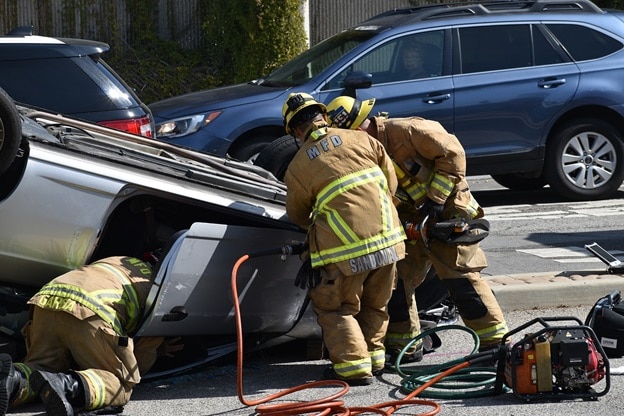The COVID-19 pandemic revealed to the world that if superheroes exist, they often appear in the form of a first responder. First responders are the ones to answer the call when someone urgently needs help. They are at the centre of some of life’s most perilous moments, racing to the rescue when a crisis occurs. It’s little wonder, then, that first responders are often at the forefront of some of television’s most popular and acclaimed dramas.
But how accurate are television’s portrayals of first responders, really?
Live, Laugh, Love
TV shows capture and keep their audiences based on their ability to tell riveting stories. And that means that ratcheting up the drama is pretty much par for the course. A steady diet of TV drama, particularly older and often more sensationalized series, would suggest that the world of the first responder is filled with excitement, that the first responder spends their day either embroiled in a passionate love affair, narrowly escaping the clutches of danger, deploying skill and grit to snatch a dying victim from the jaws of death, or evincing superhuman courage to thwart the most malevolent of criminals.
Fortunately, contemporary television appears to be taking a more nuanced view of our first responders, downplaying a bit of the melodrama while prioritizing the real-world challenges and conflicts many face, including the realities of living with post-traumatic stress disorder (PTSD). Today’s TV series, such as the critical and popular success 911, feature characters who are all-too-human, those struggling to deal with the aftermath of all they have seen and experienced while on the job, from the deaths of children to the stark recognition of their own mortality when encountering danger themselves.
These are not the Teflon comic book heroes who laugh in the face of danger. They are real, vulnerable, and scarred people with lives and families that in many ways look very much like our own.

A Diverse Force
From ground-breaking series such as ER, Chicago Fire, and Law and Order, American television has represented the growing diversity of paramedics, police, and firefighters. Each series has featured an array of Black, Hispanic, and LGBTQ+ characters, many of whom are cast in leading roles, in the effort to more accurately reflect the heterogeneity of not only the world but also of the field of emergency services in the US and abroad.
These portrayals speak to important shifts evident in communities all across America, Specifically, members of minority communities are increasingly assuming powerful community leadership roles. And now, more than ever, such leadership is being represented through storylines that underscore the professionalism and inclusivity of our civil servants and emergency response teams.
The Role of the Social Worker
When you think of the first responder, probably the first images that come to mind are of firefighters, EMTs, and police. In fact, though, social workers are also often among the first on the scene when someone needs help.
This is because social workers act as a key resource in supporting those in crisis. They may, for example, be on hand to comfort a child who is being removed from an abusive home. Or they may use their training to provide emotional and psychological support to someone suffering a psychiatric break.
Unfortunately, though, the crucial services so often provided by social workers in emergencies are often overlooked in fictional television. When social workers are portrayed, it’s often in a deeply unflattering light. For instance, in the BBC drama, Eastenders, social workers are portrayed as callous baby-snatchers, heartlessly ripping children from their homes and devastated families.
In reality, the social worker’s principal role is to maximize the well-being of all, with a prioritization of the best interests of the most vulnerable, including children, the elderly, those with disabilities, and those who have experienced sexual or domestic violence.
Why It Matters
When you’re sitting down in front of the television at the end of a hard day, or you’re cueing up Netflix for an evening of binge-watching with the fam, you might not feel all that concerned about how authentic the portrayals of first responders might be in your favourite drama series.
But the reality is that authenticity matters, particularly when it comes to matters of diversity and inclusion. After all, when we become enthralled in a story, we project ourselves into it. We live vicariously through the characters we love.
And when those characters look like us, when they have life experiences and personal and cultural backgrounds that resemble our own, then our world gets a little bit bigger. Above all, our capacity to envision ourselves and our future expands. We can use these stories and the character with which we identify to dream a little larger and aspire a little higher.
That’s why authenticity matters: Television drama isn’t just about enjoying an entertaining story. It’s also about opening up new perspectives on life and possibility.
The Takeaway
First responders are the heroes of the real world. The pandemic taught us that. But for far too long, television drama represented these amazing EMTs, firefighters, police, and social workers as if they were better suited to a Harlequin romance series than to the gritty world we actually live in. Today, though, TV series are doing a far better job at getting it right, including showcasing the mental challenges of the work and underscoring the diversity of the field.
Watch this space for updates in the Television category on Running Wolf’s Rant.
Like what you just read? Subscribe To Our Newsletter to stay in the loop.
Feel free to explore our website or check out our Featured Articles.
Looking for a gift for that special person in your life? Check out Netflorist.co.za, South Africa's top online florist and gift service. They offer flowers, gifts, and hampers for all occasions AND reliable nationwide delivery.



